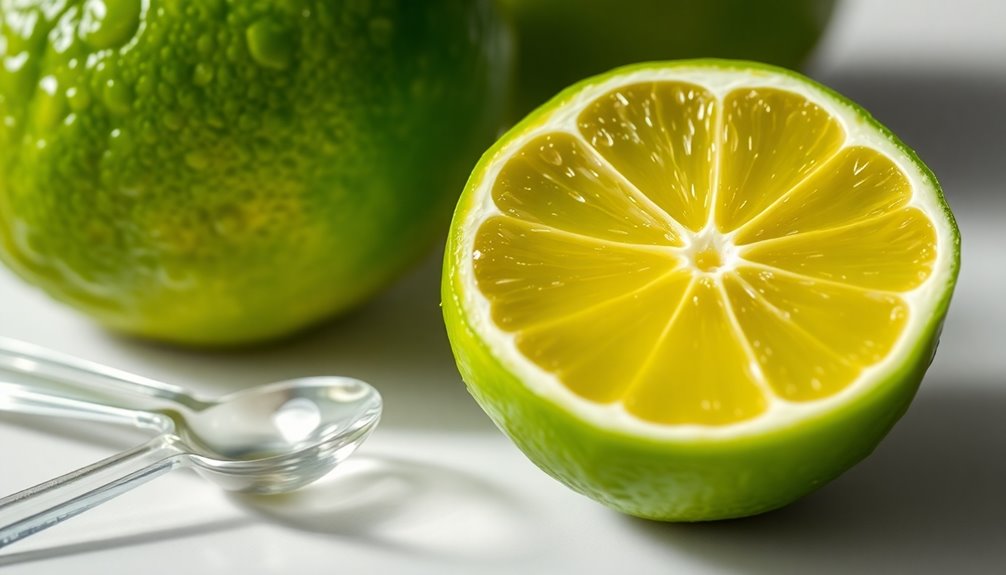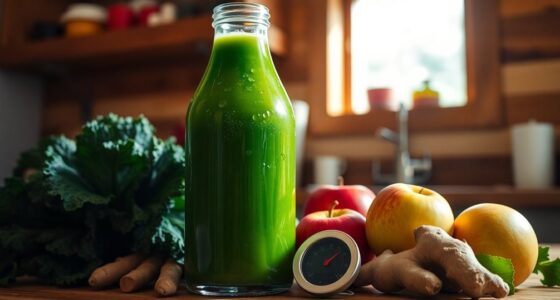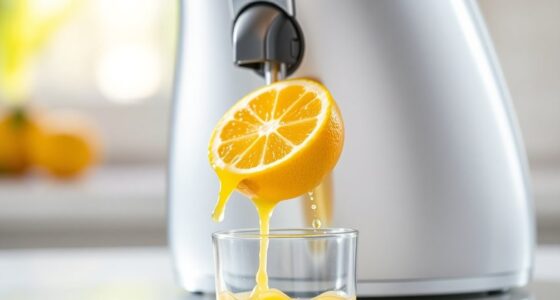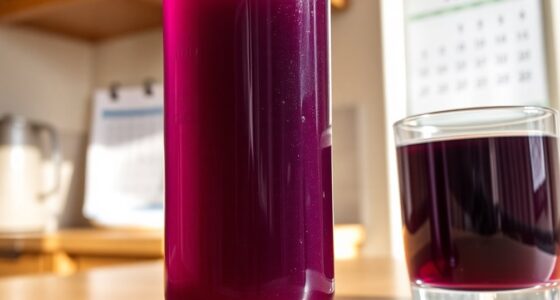Half a lime usually gives you about 1 tablespoon of juice, which is about 0.5 ounces. This amount's perfect for adding a zesty flavor to your dishes or drinks. If you're in a pinch, remember that larger or juicier limes can provide more juice, while smaller ones might require you to use a couple. Want to ensure you get every drop? There are effective techniques to maximize your lime juice yield that you might find helpful.
Key Takeaways
- Half a lime typically yields about 1 tablespoon of juice (0.5 ounces).
- The yield can vary based on the lime's size and ripeness.
- Smaller limes may produce less juice, requiring more than one for recipes.
- Juicier limes may suffice with just one for adequate juice.
- Rolling the lime before cutting can enhance juice extraction.
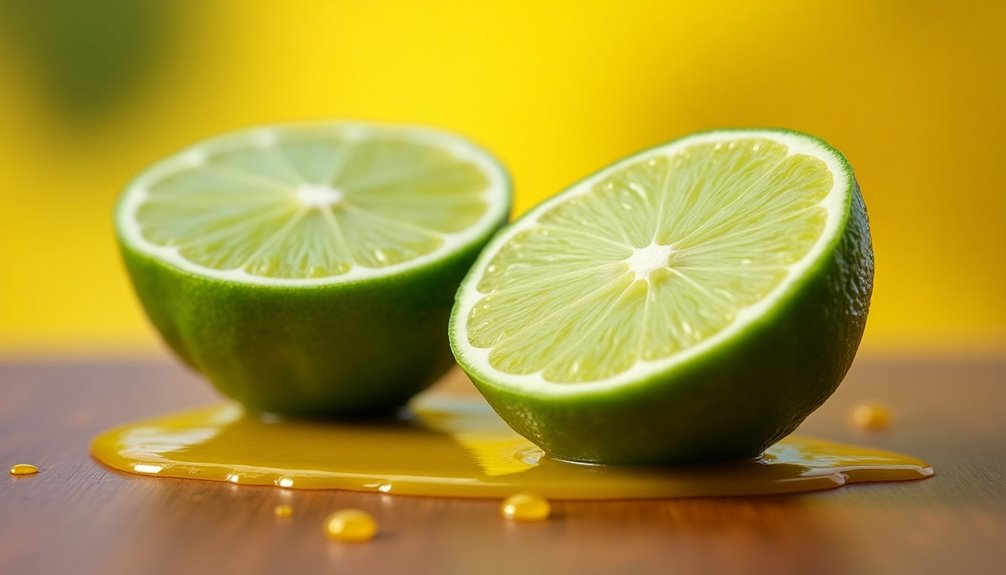
Have you ever wondered how much juice is in a lime? If you're gearing up for a recipe that calls for fresh lime juice, knowing the yield of limes can save you some hassle. Generally, one medium Persian lime produces about 2 tablespoons of juice, which is roughly equivalent to 1 ounce. If you're working with half a lime, you can expect to get about 1 tablespoon of juice, or around 0.5 ounces. This knowledge can be particularly handy when you're preparing cocktails, marinades, or any dish that needs that zesty kick of lime flavor.
When it comes to determining how much juice is in 1 lime, there's a bit of variability based on the lime's size and ripeness. On average, a single lime can yield anywhere from 1 to 3 tablespoons of juice. This means that if you're using smaller limes or those that aren't fully ripe, you might find yourself needing to use more than one to reach the desired amount of juice your recipe calls for. Conversely, if you've got larger, juicier limes, just one might be enough.
If you’re trying to measure out juice for a specific recipe, a good rule of thumb is that two limes typically yield about 1/4 cup of juice. That’s a handy measurement when you’re mixing up a refreshing drink or adding a citrusy component to a dish. Knowing this can help you avoid the guesswork, ensuring you have the right amount of lime juice to bring your culinary creation to life. When you’re unsure about how much juice in one lime, it’s helpful to remember that individual limes can vary in size, but generally, one medium lime yields about 2 tablespoons of juice. This can make it easier to adjust your measurements based on your needs, whether you’re preparing a zesty marinade or a tangy salad dressing. By keeping this in mind, you can confidently enhance your dishes with that perfect hint of lime flavor.
For those who love key lime juice, the yield is generally consistent across various lime types, including Persian limes and key limes. This consistency means you can confidently estimate how much juice you'll get from your limes, no matter which type you choose. Just keep in mind that while most recipes will give you a rough idea, factors like freshness and size can affect your yield.
If you're looking to maximize the amount of juice you can extract, try rolling the lime on a countertop before cutting it. This technique helps break down the internal membranes, making it easier to squeeze out every last drop.
Whether you're juicing for a cocktail, a dessert, or even a savory dish, getting the most out of your limes enhances the flavor and overall experience.
Frequently Asked Questions
How Much Juice Is in Half a Lime?
When you cut a medium lime in half, you can expect about 1 tablespoon of juice, which is roughly 0.5 fluid ounces.
To get the most juice, try rolling the lime on a countertop before cutting it. This little trick helps maximize extraction.
Fresh lime juice is great for enhancing the flavors of dishes and cocktails.
Can I Substitute Bottled Lime Juice for Fresh Lime Juice?
You might wonder if bottled lime juice can really replace fresh lime juice in your recipes. While it can work in a pinch, the flavor won't be as vibrant.
When you substitute, aim for 1 tablespoon of bottled juice for every tablespoon of fresh juice, but taste as you go.
For dishes that rely heavily on lime's zest, like ceviche or cocktails, fresh juice is your best bet to achieve that bright, tangy kick.
How Much Juice Does 1/2 Lemon Make?
When you cut a medium lemon in half, you can expect to get about 1.5 tablespoons of juice, which is roughly 0.75 fluid ounces.
Keep in mind that this can vary slightly based on the lemon's ripeness and size.
To get the most juice out of your lemon, roll it on the counter before cutting. This technique helps release more juice, making your recipes even more flavorful!
How Much of a Lime Is 1/2 Oz?
When life hands you limes, squeeze 'em for all they're worth!
To get 1/2 ounce of lime juice, you'll need about 1/4 of a medium lime. It's a small amount, but perfect for adding a zesty kick to your drinks or dishes.
Remember, rolling the lime before cutting helps release more juice, so don't skip that step!
With just a little, you can elevate your recipes effortlessly.
Conclusion
When you squeeze one lime, you typically get about 2 tablespoons of juice, which is around 1 ounce. This small amount can pack a powerful punch in your recipes, adding a burst of flavor to drinks, marinades, and dressings. Interestingly, just one lime can provide about 20% of your daily vitamin C needs! So, the next time you're juicing a lime, remember that even this little fruit can make a big difference in your meals and health.
Cindy thoroughly researches juicing trends, techniques, and recipes to provide readers with practical advice and inspiration. Her writing style is accessible, engaging, and designed to make complex concepts easy to understand. Cindy’s dedication to promoting the advantages of juicing shines through her work, empowering readers to make positive changes in their lives through the simple act of juicing.

